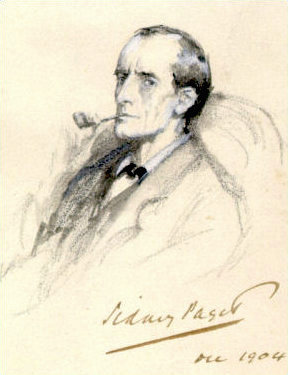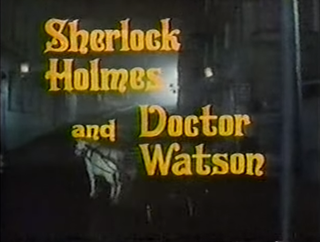Related Research Articles

Sherlock Holmes is a fictional detective created by British author Arthur Conan Doyle. Referring to himself as a "consulting detective" in his stories, Holmes is known for his proficiency with observation, deduction, forensic science and logical reasoning that borders on the fantastic, which he employs when investigating cases for a wide variety of clients, including Scotland Yard.

A Study in Scarlet is an 1887 detective novel by British writer Arthur Conan Doyle. The story marks the first appearance of Sherlock Holmes and Dr. Watson, who would become the most famous detective duo in English literature. The book's title derives from a speech given by Holmes, a consulting detective, to his friend and chronicler Watson on the nature of his work, in which he describes the story's murder investigation as his "study in scarlet": "There's the scarlet thread of murder running through the colourless skein of life, and our duty is to unravel it, and isolate it, and expose every inch of it."

The Valley of Fear is the fourth and final Sherlock Holmes novel by British writer Arthur Conan Doyle. It is loosely based on the Molly Maguires and Pinkerton agent James McParland. The story was first published in the Strand Magazine between September 1914 and May 1915. The first book edition was copyrighted in 1914, and it was first published by George H. Doran Company in New York on 27 February 1915, and illustrated by Arthur I. Keller.

Detective Inspector G. Lestrade, or Mr. Lestrade, is a fictional character appearing in several of the Sherlock Holmes stories written by Arthur Conan Doyle. Lestrade's first appearance was in the first Sherlock Holmes story, the novel A Study in Scarlet, which was published in 1887. The last story in which he appears is the short story "The Adventure of the Three Garridebs", which was first published in 1924 and was included in the final collection of Sherlock Holmes stories by Doyle, The Case-Book of Sherlock Holmes.
The stories of Sherlock Holmes by Sir Arthur Conan Doyle have been very popular as adaptations for the stage, and later film, and still later television. The four volumes of the Universal Sherlock Holmes (1995) compiled by Ronald B. De Waal lists over 25,000 Holmes-related productions and products. They include the original writings, "together with the translations of these tales into sixty-three languages, plus Braille and shorthand, the writings about the Writings or higher criticism, writings about Sherlockians and their societies, memorials and memorabilia, games, puzzles and quizzes, phonograph records, audio and video tapes, compact discs, laser discs, ballets, films, musicals, operettas, oratorios, plays, radio and television programs, parodies and pastiches, children's books, cartoons, comics, and a multitude of other items — from advertisements to wine — that have accumulated throughout the world on the two most famous characters in literature."

Traditionally, the canon of Sherlock Holmes consists of the 56 short stories and four novels written by Sir Arthur Conan Doyle. In this context, the term "canon" is an attempt to distinguish between Doyle's original works and subsequent works by other authors using the same characters. Usually capitalized by aficionados of the Sherlockian game as "the Canon", the description of these 60 adventures as the Sherlock Holmes canon and the game of applying the methods of "Higher Criticism" to it was started by Ronald Knox as a playful use of the traditional definition of canon as an authoritative list of books accepted as holy scripture.

A series of fourteen films based on Sir Arthur Conan Doyle's Sherlock Holmes stories was released between 1939 and 1946; British actors Basil Rathbone and Nigel Bruce portrayed Sherlock Holmes and Dr. John Watson, respectively. The first two films in the series were produced by 20th Century-Fox and released in 1939. After these two films, Universal Pictures acquired the rights from the Doyle estate and produced a further twelve films.

A Study in Scarlet is a 1914 British silent drama film directed by George Pearson and starring James Bragington, making him the first English actor to portray Holmes on film. It is based on the Sir Arthur Conan Doyle 1887 novel of the same name and is considered to be lost. An American film of the same name was released in the U.S. on the following day, 29 December 1914. As of 2014, the film is missing from the BFI National Archive, and is listed as one of the British Film Institute's "75 Most Wanted" lost films.
Sherlock Holmes is the overall title given to the BBC Radio 4 radio dramatisations of the complete Sherlock Holmes stories, with Bert Coules as head writer, and featuring Clive Merrison as Holmes and Michael Williams as Dr Watson. Together, the two actors completed radio adaptations of every story in the canon of Sherlock Holmes between 1989 and 1998.

The Triumph of Sherlock Holmes is a 1935 British mystery film directed by Leslie S. Hiscott and starring Arthur Wontner. It was based on the 1915 Sherlock Holmes novel The Valley of Fear by Arthur Conan Doyle.
This article describes minor characters from the Sherlock Holmes stories by Sir Arthur Conan Doyle, and from non-canonical derived works. The list excludes the titular character as well as Dr. Watson, Professor Moriarty, Inspector Lestrade, Mycroft Holmes, Mrs. Hudson, Irene Adler, Colonel Moran, the Baker Street Irregulars, and characters not significant enough to mention.

Harry Arthur Saintsbury, usually called H. A. Saintsbury, was an English actor and playwright. A leading man, he became well known for his stage interpretation of Sherlock Holmes, was an early mentor of Charlie Chaplin, and is considered an authority on the work of Sir Henry Irving.

The Hound of the Baskervilles is a 1983 British made-for-television mystery thriller film directed by Douglas Hickox, starring Ian Richardson as Sherlock Holmes and Donald Churchill as Dr. John H. Watson. It is based on Arthur Conan Doyle's 1902 novel The Hound of the Baskervilles.

Hubert Willis was a British actor best known for his recurring role as Doctor Watson in a series of silent Sherlock Holmes films co-starring with Eille Norwood.
The Sign of Four is a 1923 British silent mystery film directed by Maurice Elvey and starring Eille Norwood, Isobel Elsom and Fred Raynham. The film is based on the 1890 novel The Sign of the Four by Arthur Conan Doyle, and was one of a series of Sherlock Holmes films starring Norwood.

Sherlock Holmes is a four-act play by William Gillette and Sir Arthur Conan Doyle, based on Conan Doyle's character Sherlock Holmes. After three previews it premiered on Broadway November 6, 1899, at the Garrick Theatre in New York City.
From 1921 to 1923, Stoll Pictures produced three series of silent black-and-white films based on Sir Arthur Conan Doyle's Sherlock Holmes stories. Forty-five short films and two feature-length films were produced featuring Eille Norwood in the role of Holmes and Hubert Willis cast as Dr. Watson with the exception of the final film, The Sign of Four, where Willis was replaced with Arthur Cullin. Consequently, Norwood holds the record for most appearances as Sherlock Holmes in film.

Sherlock Holmes and Doctor Watson is a television series created by Sheldon Reynolds and based on characters and storylines from Sir Arthur Conan Doyle's Sherlock Holmes stories. It starred Geoffrey Whitehead, Donald Pickering and Patrick Newell in the title roles of Sherlock Holmes, Doctor Watson and Inspector Lestrade respectively. The series is considered rather obscure, and was filmed on a relatively low budget in Poland. The series combined adaptations of Arthur Conan Doyle's source stories with original screenplays that saw Holmes face brand new cases.
The Adventures of Sherlock Holmes is an American old-time radio show that aired on US radio networks between 1930 and 1936. The series was adapted from Sir Arthur Conan Doyle's Sherlock Holmes stories by scriptwriter Edith Meiser. For most of the series, Richard Gordon played Sherlock Holmes and Leigh Lovell played Dr. Watson.
The Speckled Band is a 1910 play in three acts by Sir Arthur Conan Doyle, based on his own 1892 short story "The Adventure of the Speckled Band".
References
- ↑ BFI Database entry
- ↑ "The Valley of Fear". silentera.com. Retrieved 10 March 2013.
- 1 2 3 4 Boström, Mattias (2018). From Holmes to Sherlock. Mysterious Press. p. 155. ISBN 978-0-8021-2789-1.
- ↑ Eyles, Allen (1986). Sherlock Holmes: A Centenary Celebration . Harper & Row. pp. 57–58. ISBN 0-06-015620-1.
- ↑ Barnes, Alan (2011). Sherlock Holmes on Screen. Titan Books. p. 295. ISBN 9780857687760.